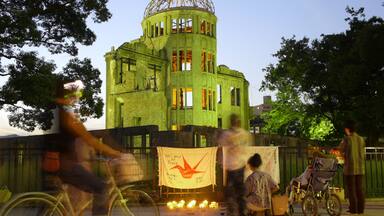Hiroshima Peace Memorial (Genbaku Dome)
Hiroshima Peace Memorial (Genbaku Dome)
The Hiroshima Peace Memorial (Genbaku Dome) was the only structure left standing in the area where the first atomic bomb exploded on 6 August 1945. Through the efforts of many people, including those of the city of Hiroshima, it has been preserved in the same state as immediately after the bombing. Not only is it a stark and powerful symbol of the most destructive force ever created by humankind; it also expresses the hope for world peace and the ultimate elimination of all nuclear weapons.
Description is available under license CC-BY-SA IGO 3.0
Mémorial de la paix d'Hiroshima (Dôme de Genbaku)
Le Mémorial de la Paix d'Hiroshima, ou Dôme de Genbaku, fut le seul bâtiment à rester debout près du lieu où explosa la première bombe atomique, le 6 août 1945. Il a été préservé tel qu'il était juste après le bombardement grâce à de nombreux efforts, dont ceux des habitants d'Hiroshima, en espérant une paix durable et l'élimination finale de toutes les armes nucléaires de la planète. C'est un symbole dur et puissant de la force la plus destructrice que l'homme ait jamais créée, qui incarne en même temps l'espoir de la paix.
Description is available under license CC-BY-SA IGO 3.0
النصب التذكاري للسلام في هيروشيما (قبّة جينباكو)
يُعتبَر النصب التذكاري للسلام في هيروشيما، أو قبة جينباكو، المبنى الوحيد المتبقّي قرب المكان حيث انفجرت القنبلة النوويّة الأولى في 6 آب أغسطس 1945. وقد تمّت المحافظة على الشكل الذي كان عليه بعد قصف القنبلة، وذلك بفضل جهودٍ حثيثةٍ،ٍ نذكر منها جهود سكّان هيروشيما الذين يتطلّعون إلى السلام الدائم والتخلّص نهائيًّا من الأسلحة النوويّة كافةً على الكرة الأرضيّة. فهذا النّصب رمزٌ متين وصلبٌ للقوّة الأكثر تدميرًا التي اخترعها الإنسان حتى الآن، وفي الوقت نفسه رمز لجنوح الإنسان نحو السلام والمل به.
source: UNESCO/CPE
Description is available under license CC-BY-SA IGO 3.0
广岛和平纪念公园(原爆遗址)
广岛和平纪念公园是1945年8月6日广岛原子弹爆炸区留下的唯一一处建筑。通过许多人的努力,包括广岛市民的努力,这个遗址被完好地保留了下来,一直保持着遭受原子弹袭击后的样子。广岛和平纪念公园不仅是人类历史上创造的最具毁灭性力量的象征,而且体现了全世界人们追求和平,最终全面销毁核武器的愿望。
source: UNESCO/CPE
Description is available under license CC-BY-SA IGO 3.0
Мемориал Мира в Хиросиме (купол Генбаку)
Купол Генбаку был единственным сооружением, уцелевшим на месте взрыва первой атомной бомбы 6 августа 1945 г. Стараниями многих людей, включая жителей Хиросимы, оно сохранено в том самом виде, каким было сразу после взрыва. Мемориал Мира не только яркий и мощный символ самой разрушительной силы, когда-либо созданной человечеством. Это выражение надежды на мир во всем мире и окончательное уничтожение всего ядерного оружия.
source: UNESCO/CPE
Description is available under license CC-BY-SA IGO 3.0
Memorial de la Paz en Hiroshima (Cúpula de Genbaku)
El Memorial de la Paz de Hiroshima, llamado también la Cúpula de Genbaku, es la estructura del único edificio que permaneció en pie cerca del lugar donde explotó la primera bomba atómica el 6 de agosto de 1945. Gracias a los esfuerzos de innumerables personas –y en particular de los propios habitantes de Hiroshima– se ha conservado en el mismo estado en que quedó después de la explosión. Este sitio no sólo es un símbolo descarnado y recio de la fuerza más destructiva creada por el hombre en toda su historia, sino también una encarnación de los anhelos de paz mundial y de una supresión definitiva de todas las armas nucleares.
source: UNESCO/CPE
Description is available under license CC-BY-SA IGO 3.0
原爆ドーム
source: NFUAJ
Vredesmonument van Hiroshima (Genbakukoepel)
Source: unesco.nl
Outstanding Universal Value
Brief synthesis
The Hiroshima Peace Memorial (Genbaku Dome) is the only structure left standing near the hypocenter of the first atomic bomb which exploded on 6 August 1945, and it remains in the condition right after the explosion. Through the efforts of many people, including those of the city of Hiroshima, this ruin has been preserved in the same state as immediately after the bombing. Not only is it a stark and powerful symbol of the most destructive force ever created by humankind, it also expresses the hope for world peace and the ultimate elimination of all nuclear weapons. The inscribed property covers 0.40 ha in the urban centre of Hiroshima and consists of the surviving Genbaku Dome (“Genbaku” means atomic bomb in Japanese) within the ruins of the building. The 42.7 ha buffer zone that surrounds the property includes the Peace Memorial Park.
The most important meaning of the surviving structure of the Hiroshima Peace Memorial is in what it symbolizes, rather than just its aesthetic and architectural values. This silent structure is the skeletal form of the surviving remains of the Hiroshima Prefectural Industrial Promotional Hall (constructed in 1914). It symbolizes the tremendous destructive power, which humankind can invent on the one hand; on the other hand, it also reminds us of the hope for world permanent peace.
Criterion (vi): The Hiroshima Peace Memorial (Genbaku Dome) is a stark and powerful symbol of the achievement of world peace for more than half a century following the unleashing of the most destructive force ever created by humankind.
Integrity
The Hiroshima Peace Memorial (Genbaku Dome) has been preserved as a ruin. It is all that remains of the Hiroshima Prefectural Industrial Promotional Hall ‘Hiroshima-ken Sangyo Shoreikan’ after the 1945 nuclear bomb blast. Inside the property, all the structural elements of the building remain in the same state as immediately after the bombing, and are well preserved. The property can be observed from the outside of the periphery fences and its external and internal integrity is well maintained. The buffer zone, including Hiroshima Peace Memorial Park, is defined both as a place for prayer for the atomic bomb victims as well as for permanent world peace.
Authenticity
In the last three conservation projects (1967, 1989-1990 and 2002-2003), minimum reinforcement with steel and synthetic resin was used in order to preserve the condition of the dome as it was after the atomic bomb attack. The Hiroshima Peace Memorial (Genbaku Dome) stands in its original location and its form, design, materials, substance, and setting are all completely authentic. It also maintains its functional and spiritual authenticity as a place for prayer for world peace and the ultimate elimination of all nuclear weapons.
Protection and management requirements
The Hiroshima Peace Memorial (Genbaku Dome) is designated as a historic site under Japanese 1950 Law for the Protection of Cultural Properties, and is managed by Hiroshima City under the guidance by the Hiroshima Prefectural Government and the Government of Japan. Financial and technical support is available from the Government of Japan. The park management office of Hiroshima City is located inside the Hiroshima Peace Memorial Park, and daily maintenance is conducted in cooperation with the division in charge of protecting cultural properties. Hiroshima City also conducts a detailed survey of its condition once every three years. A city beautification plan was developed by Hiroshima City that calls for this area to remain an attractive space appropriate to a symbol of the International Peace Culture City. Based on this beautification plan, landscape management standards seek to implement consultation for building height and alignment, as well as wall colors, materials and advertisement boards in the vicinity of the Hiroshima Peace Memorial Park included within the buffer zone. The protection of Peace Memorial Park was enhanced in 2007 with its designation as a Place for Scenic Beauty under the 1950 Law for the Protection of Cultural Properties.

 View photos from OUR PLACE the World Heritage collection
View photos from OUR PLACE the World Heritage collection
